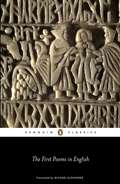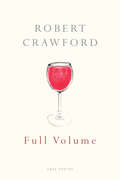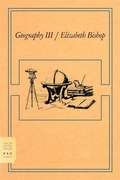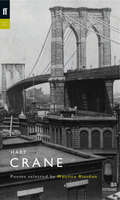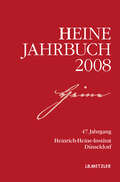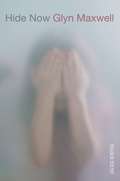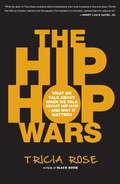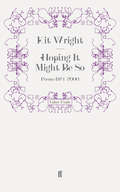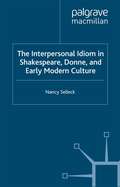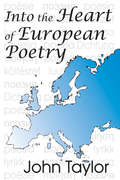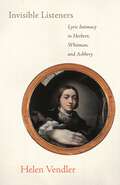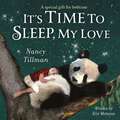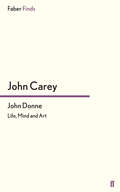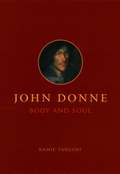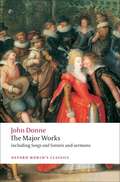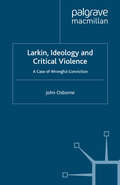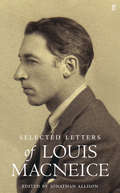- Table View
- List View
The First Poems in English (Penguin Classics)
by Michael AlexanderThis selection of the earliest poems in English comprises works from an age in which verse was not written down, but recited aloud and remembered. Heroic poems celebrate courage, loyalty and strength, in excerpts from Beowulf and in The Battle of Brunanburgh, depicting King Athelstan’s defeat of his northern enemies in 937 AD, while The Wanderer and The Seafarer reflect on exile, loss and destiny. The Gnomic Verses are proverbs on the natural order of life, and the Exeter Riddles are witty linguistic puzzles. Love elegies include emotional speeches from an abandoned wife and separated lovers, and devotional poems include a vision of Christ’s cross in The Dream of the Rood, and Caedmon’s Hymn, perhaps the oldest poem in English, speaking in praise of God.
Full Volume
by Robert CrawfordHolding in balance the ecological and the technological, ancient and modern, Full Volume sings languages and cultures, people and habitats burgeoning on the brink of extinction. From revved-up battle-cry to nervous whisper, these lyrical poems praise intricate abundance. Assured in its rhymes and cadences, Full Volume is often attentive to poetry in other tongues, not least Gaelic. As their tones and forms shift from the spiritual to the wry, from haiku to brosnachadh, the poems' resonance and music build into a sustained sounding of what it means to live, love, and listen in a world where 'Nothing is ever single'.
Geography III (FSG Classics) (PDF)
by Elizabeth BishopWhether writing about waiting as a child in a dentist's office, viewing a city from a plane high above, or losing items ranging from door keys to one's lover in the masterfully restrained "One Art," Elizabeth Bishop somehow conveyed both large and small emotional truths in language of stunning exactitude and even more astonishing resonance. As John Ashbery has written, "The private self . . . melts imperceptibly into the large utterance, the grandeur of poetry, which, because it remains rooted in everyday particulars, never sounds 'grand,' but is as quietly convincing as everyday speech. "
The Half Healed
by Michael Symmons RobertsThe poems in Michael Symmons Roberts's fifth collection move in a world riven by violence and betrayal, between nations and individuals. As ever, this is a metaphysical poetry rooted in physical detail - but the bodies here are displaced, disguised, in need of rescue. A man in a fox suit prowls the woods afraid of meeting true foxes, while a vixen dressed as a man moves among the powerful at society soirées. God no longer 'walks in his garden in the cool of the day', but drives through a damaged city in the small hours. At the same time a couple celebrate armistice with an act of love in an anonymous hotel room. As the judges of the Whitbread Prize noted, Roberts' poetry 'inspires profound meditation on the nature of the soul, the body, the stars and the heart - and sparks revelation.' Roberts is a poet of unusual range and dexterity, fascinated by faith and science, by the physical and the transcendental, and with this new book he confirms his position as a truly original, and thrillingly gifted, lyric poet.
Hart Crane (Poet To Poet Ser. #41)
by Maurice RiordanHarold Hart Crane was born in Ohio in 1899. In 1923 he became a copy-writer in New York. White Buildings, his first collection, appeared in 1926, and in 1930 his most famous work, The Bridge, was published. A reaction against the pessimism in T. S. Eliot's The Waste Land, The Bridge was a love song to the myth of America and its optimism a much needed boon to post-Wall Street Crash America. Hart Crane committed suicide in 1932.
Heine-Jahrbuch 2008: 47. Jahrgang
by Heinrich-Heine-Gesellschaft Heinrich-Heine-Institut Heinrich-Heine-Institut DüsseldorfJüngste Forschungen zu Heine. Ein Schwerpunkt des Jahrbuchs ist die Musik: Reaktionen Heines und Daumiers auf Phänomene des Pariser Musiklebens; Musik und ihre Interpreten in den Schriften Börnes; Rachmaninows Heine-Vertonungen. Außerdem: Umgang mit Person und Werk Heines im Nationalsozialismus und Heines "Lutezia".
Hide Now
by Glyn MaxwellIn Hide Now, Glyn Maxwell shows how the times have begun to warp time itself: in the poet’s vision, the past rears up again with its angry ghosts, the present is racked by its martial and climatic nightmares, and the future has already come and gone. All the stories of the earth seem menaced by just one – to which nations cover their eyes and ears, and from which the grown-ups run and hide. Scheherazade, Robespierre, Dick Cheney and the Reverend Jim Jones all have their place here, though the book’s presiding genius is the lonely figure of Cassandra, cursed with knowing the fate of a world that finds her screamingly funny. Glyn Maxwell has established an international reputation as one of the most intelligent and stylishly original English poets since Auden, and he has never written with greater urgency or power. ‘[Maxwell’s] astonishing technical facility can make syllables, vowels and consonants do absolutely anything. His energetic voice riffs through evasively ordinary speech taking on love, politics, comedy and bizarre narratives in brilliantly elaborate syntax and forms’ Independent
The Hip Hop Wars: What We Talk About When We Talk About Hip Hop--and Why It Matters
by Tricia RoseHow hip hop shapes our conversations about race--and how race influences our consideration of hip hop Hip hop is a distinctive form of black art in America-from Tupac to the Pulitzer Prize-winning Kendrick Lamar, hip hop has long given voice to the African American experience. As scholar and cultural critic Tricia Rose argues, hip hop, in fact, has become one of the primary ways we talk about race in the United States. But hip hop is in crisis. For years, the most commercially successful hip hop has become increasingly saturated with caricatures of black gangstas, thugs, pimps, and hos. This both represents and feeds a problem in black American culture. Or does it? In The Hip-Hop Wars, Rose explores the most crucial issues underlying the polarized claims on each side of the debate: Does hip hop cause violence, or merely reflect a violent ghetto culture? Is hip hop sexist, or are its detractors simply anti-sex? Does the portrayal of black culture in hip hop undermine black advancement?A potent exploration of a divisive and important subject, The Hip Hop Wars concludes with a call for the regalvanization of the progressive and creative heart of hip hop. What Rose calls for is not a sanitized vision of the form, but one that more accurately reflects a much richer space of culture, politics, anger, and yes, sex, than the current ubiquitous images in sound and video currently provide.
Hoping It Might Be So: Poems 1974-2000
by Kit WrightHoping It Might Be So brings together all of Kit Wright's previous collections for adults as well as three dozen new poems. The collection, first published in 2000, was described by Christina Patterson in the Sunday Times as 'funny and profoundly humane' and by Sophie Hannah in the PN Review as 'full of verve and energy, with a strong musical quality that makes you want to read on and hear more'. Sean O'Brien in the Times Literary Supplement described Kit Wright as 'a masterly yet modest poet' while Ruth Padel in the Independent on Sunday said that 'all through his work there is that poignancy, darkness, brush with despair, which marks great comic work.' The poet Anthony Wilson said that Wright 'can be funny, serious and moving, and sometimes all three in the space of a single poem'.Hoping It Might Be So is a rewarding collection from an interesting, prolific and lively poet whose poems range from ribald to grief-stricken, elegiac to rambunctious
The Interpersonal Idiom in Shakespeare, Donne, and Early Modern Culture
by N. SelleckThe Interpersonal Idiom offers a timely reformulation of identity in the age of Shakespeare, recovering a rich and now obsolete language that casts selfhood not as subjective experience but as the experience of others.
Into the Heart of European Poetry
by John TaylorJohn Taylor's brilliant new book examines the work of many of the major poets who have deeply marked modern and contemporary European literature. Venturing far and wide from the France in which he has lived since the late 1970s, the polyglot writer-critic not only delves into the more widely translated literatures of Italy, Greece, Germany, and Austria, but also discovers impressive and overlooked work in Slovenia, Bosnia, Hungary, Finland, Norway, and the Netherlands in this book that ranges over nearly all of Europe, including Russia.While providing this stimulating and far-ranging critical panorama, Taylor brings to light key themes of European writing: the depth of everyday life, the quest of the thing-in-itself, metaphysical aspiration and anxiety, the dialectics of negativity and affirmation, subjectivity and self-effacement, and uprootedness as a category that is as ontological as it is geographical, historical, political, or cultural. The book pays careful attention to the intersection of writing and history (or politics), as several poets featured here have faced the Second World War, the Holocaust, Communism, the fall of Communism, or the war in the former Yugoslavia.Taylor gives the work of renowned, upcoming, and still little-known poets a thorough look, all the while scrutinizing recent translations of their verse. He highlights several poets who are also masters of the prose poem. He includes a few novelists who have fashioned a particularly original kind of poetic prose, that stylistic category that has proved so difficult for critics to define. Into the Heart of European Poetry should be of immediate interest to any reader curious about the aesthetic and philosophical ideas underlying major trends of contemporary European writing. In a day and age when much too little is translated and thus known about foreign literature, and when Europeans themselves are pondering the common denominators of their own culture, this book is a
Into the Heart of European Poetry
by John TaylorJohn Taylor's brilliant new book examines the work of many of the major poets who have deeply marked modern and contemporary European literature. Venturing far and wide from the France in which he has lived since the late 1970s, the polyglot writer-critic not only delves into the more widely translated literatures of Italy, Greece, Germany, and Austria, but also discovers impressive and overlooked work in Slovenia, Bosnia, Hungary, Finland, Norway, and the Netherlands in this book that ranges over nearly all of Europe, including Russia.While providing this stimulating and far-ranging critical panorama, Taylor brings to light key themes of European writing: the depth of everyday life, the quest of the thing-in-itself, metaphysical aspiration and anxiety, the dialectics of negativity and affirmation, subjectivity and self-effacement, and uprootedness as a category that is as ontological as it is geographical, historical, political, or cultural. The book pays careful attention to the intersection of writing and history (or politics), as several poets featured here have faced the Second World War, the Holocaust, Communism, the fall of Communism, or the war in the former Yugoslavia.Taylor gives the work of renowned, upcoming, and still little-known poets a thorough look, all the while scrutinizing recent translations of their verse. He highlights several poets who are also masters of the prose poem. He includes a few novelists who have fashioned a particularly original kind of poetic prose, that stylistic category that has proved so difficult for critics to define. Into the Heart of European Poetry should be of immediate interest to any reader curious about the aesthetic and philosophical ideas underlying major trends of contemporary European writing. In a day and age when much too little is translated and thus known about foreign literature, and when Europeans themselves are pondering the common denominators of their own culture, this book is a
Invisible Listeners: Lyric Intimacy in Herbert, Whitman, and Ashbery
by Helen VendlerWhen a poet addresses a living person--whether friend or enemy, lover or sister--we recognize the expression of intimacy. But what impels poets to leap across time and space to speak to invisible listeners, seeking an ideal intimacy--George Herbert with God, Walt Whitman with a reader in the future, John Ashbery with the Renaissance painter Francesco Parmigianino? In Invisible Listeners, Helen Vendler argues that such poets must invent the language that will enact, on the page, an intimacy they lack in life. Through brilliantly insightful and gracefully written readings of these three great poets over three different centuries, Vendler maps out their relationships with their chosen listeners. For his part, Herbert revises the usual "vertical" address to God in favor of a "horizontal" one-addressing God as a friend. Whitman hovers in a sometimes erotic, sometimes quasi-religious language in conceiving the democratic camerado, who will, following Whitman's example, find his true self. And yet the camerado will be replaced, in Whitman's verse, by the ultimate invisible listener, Death. Ashbery, seeking a fellow artist who believes that art always distorts what it represents, finds he must travel to the remote past. In tones both tender and skeptical he addresses Parmigianino, whose extraordinary self-portrait in a convex mirror furnishes the poet with both a theory and a precedent for his own inventions. By creating the forms and speech of ideal intimacy, these poets set forth the possibility of a more complete and satisfactory human interchange--an ethics of relation that is uncoerced, understanding, and free.
Invisible Listeners: Lyric Intimacy in Herbert, Whitman, and Ashbery
by Helen VendlerWhen a poet addresses a living person--whether friend or enemy, lover or sister--we recognize the expression of intimacy. But what impels poets to leap across time and space to speak to invisible listeners, seeking an ideal intimacy--George Herbert with God, Walt Whitman with a reader in the future, John Ashbery with the Renaissance painter Francesco Parmigianino? In Invisible Listeners, Helen Vendler argues that such poets must invent the language that will enact, on the page, an intimacy they lack in life. Through brilliantly insightful and gracefully written readings of these three great poets over three different centuries, Vendler maps out their relationships with their chosen listeners. For his part, Herbert revises the usual "vertical" address to God in favor of a "horizontal" one-addressing God as a friend. Whitman hovers in a sometimes erotic, sometimes quasi-religious language in conceiving the democratic camerado, who will, following Whitman's example, find his true self. And yet the camerado will be replaced, in Whitman's verse, by the ultimate invisible listener, Death. Ashbery, seeking a fellow artist who believes that art always distorts what it represents, finds he must travel to the remote past. In tones both tender and skeptical he addresses Parmigianino, whose extraordinary self-portrait in a convex mirror furnishes the poet with both a theory and a precedent for his own inventions. By creating the forms and speech of ideal intimacy, these poets set forth the possibility of a more complete and satisfactory human interchange--an ethics of relation that is uncoerced, understanding, and free.
It's Time to Sleep, My Love
by Nancy TillmanAs comforting as a soft blanket and warm as a goodnight hug, Eric Metaxas' lullaby It's Time to Sleep, My Love is delightfully brought to life by bestselling artist Nancy Tillman (On the Night You Were Born), whose illustrations celebrate the wonders of the natural world, and the bonds of family.It's time to sleep, it's time to sleep,the fishes croon in waters deep.The songbirds sing in trees above,"It's time to sleep, my love, my love."As children prepare for bed, the world around them is also settling down for the night. Animals – who live in the jungle, the forest, the sea – all whisper to their babies a soft refrain: "It's time to sleep, my love."
John Donne: Life, Mind and Art
by Professor John Carey'Donne is perhaps the most intellectual of English poets, and John Carey is perhaps the most intelligent of contemporary English literary critics. The encounter, as one might expect, is fierce and enthralling... This book is sensitive, searching, powerful, exciting, provocative and witty. It is a superb achievement.' Christopher Hill, TLSJohn Donne: Life, Mind and Art is a unique attempt to see Donne whole. Beginning with an account of his life, it takes as its domain not only the whole range of the poetry, but also the sermons, the letters, the spiritual and controversial works, and such highly personal documents as the treatise on suicide. The result is a clearer picture than has hitherto emerged of one of the most intricate and compelling of literary personalities.'The one book we have needed all along... A magnificent exercise in reappraisal. I have never read a critical work which reaches as deeply inside the mind of its subject.' Jonathan Raban, Sunday Times'Carey's book is itself alive with the kind of energy it attributes to Donne.' Christopher Ricks, London Review of Books
John Donne, Body and Soul
by Ramie TargoffFor centuries readers have struggled to fuse the seemingly scattered pieces of Donne’s works into a complete image of the poet and priest. In John Donne, Body and Soul, Ramie Targoff offers a way to read Donne as a writer who returned again and again to a single great subject, one that connected to his deepest intellectual and emotional concerns. Reappraising Donne’s oeuvre in pursuit of the struggles and commitments that connect his most disparate works, Targoff convincingly shows that Donne believed throughout his life in the mutual necessity of body and soul. In chapters that range from his earliest letters to his final sermon, Targoff reveals that Donne’s obsessive imagining of both the natural union and the inevitable division between body and soul is the most continuous and abiding subject of his writing. “Ramie Targoff achieves the rare feat of taking early modern theology seriously, and of explaining why it matters. Her book transforms how we think about Donne.”—Helen Cooper, University of Cambridge
John Donne, Body and Soul
by Ramie TargoffFor centuries readers have struggled to fuse the seemingly scattered pieces of Donne’s works into a complete image of the poet and priest. In John Donne, Body and Soul, Ramie Targoff offers a way to read Donne as a writer who returned again and again to a single great subject, one that connected to his deepest intellectual and emotional concerns. Reappraising Donne’s oeuvre in pursuit of the struggles and commitments that connect his most disparate works, Targoff convincingly shows that Donne believed throughout his life in the mutual necessity of body and soul. In chapters that range from his earliest letters to his final sermon, Targoff reveals that Donne’s obsessive imagining of both the natural union and the inevitable division between body and soul is the most continuous and abiding subject of his writing. “Ramie Targoff achieves the rare feat of taking early modern theology seriously, and of explaining why it matters. Her book transforms how we think about Donne.”—Helen Cooper, University of Cambridge
John Donne, Body and Soul
by Ramie TargoffFor centuries readers have struggled to fuse the seemingly scattered pieces of Donne’s works into a complete image of the poet and priest. In John Donne, Body and Soul, Ramie Targoff offers a way to read Donne as a writer who returned again and again to a single great subject, one that connected to his deepest intellectual and emotional concerns. Reappraising Donne’s oeuvre in pursuit of the struggles and commitments that connect his most disparate works, Targoff convincingly shows that Donne believed throughout his life in the mutual necessity of body and soul. In chapters that range from his earliest letters to his final sermon, Targoff reveals that Donne’s obsessive imagining of both the natural union and the inevitable division between body and soul is the most continuous and abiding subject of his writing. “Ramie Targoff achieves the rare feat of taking early modern theology seriously, and of explaining why it matters. Her book transforms how we think about Donne.”—Helen Cooper, University of Cambridge
John Donne - The Major Works - Oxford World's Classics: 400MB file
by John Donne John CareyThis authoritative edition was formerly published in the acclaimed Oxford Authors series under the general editorship of Frank Kermode. It brings together a unique combination of Donne's poetry and prose - all the major poems, complemented by rarely published letters and extracts from Donne's sermons - to give the essence of his work and thinking. John Donne (1572-1631) is today celebrated as one of the greatest of the metaphysical poets, whose verse was daringly original and whose use of imagery and conceits marked a new, intellectual approach to poetry. His Satires, Elegies, and Songs and Sonnets, which contain his most famous love poems, were complemented by his religious writing, both verse and prose. He was one of the most renowned preachers of his day, and this volume does equal justice to the full range of his work. In addition to nearly all his English poetry this volume includes over 130 extracts from Donne's sermons, as well as the full text of his last sermon, 'Death's Duel'. A distinguishing feature of the selection is that the works are arranged in the chronological order of their composition. ABOUT THE SERIES: For over 100 years Oxford World's Classics has made available the widest range of literature from around the globe. Each affordable volume reflects Oxford's commitment to scholarship, providing the most accurate text plus a wealth of other valuable features, including expert introductions by leading authorities, helpful notes to clarify the text, up-to-date bibliographies for further study, and much more.
Larkin, Ideology and Critical Violence: A Case of Wrongful Conviction
by J. OsborneThis volume combines a theoretical critique of the biographical method that dominates Larkin studies with a revolutionary interpretation of his works that better accounts for their profound influence upon leading Postmodernists like Ian McEwan, David Mitchell, Carol Ann Duffy, Damien Hirst - and the creators of Jerry Springer - the Opera .
Le Gothic: Influences and Appropriations in Europe and America
by Avril HornerThis new collection of essays by major scholars in the field looks at the ways in which cross-fertilization has taken place in Gothic writing from France, Germany, Britain and America over the last 200 years, and argues that Gothic writing reflects international exchanges in theme and form.
Letters of Louis MacNeice
by Louis MacNeiceLouis MacNeice is increasingly recognised as one of the greatest poets of the twentieth century, and his work has been a defining influence upon a generation of Irish poets that includes Derek Mahon, Michael Longley and Paul Muldoon.The Selected Letters is indispensable as a resource for an understanding of the intellectual culture of the mid-twentieth century. A Classics don, poet, playwright and globetrotting BBC producer, the medley and blend of MacNeice's cultural influences seems exemplary in its modernity. He kept up a significant correspondence with E. R. Dodds, Anthony Blunt and T. S. Eliot, to name but three prominent figures of the time.During his time at the BBC MacNeice witnessed many key events, including the partition of India in 1947 and the independence of the Gold Coast from Britain in 1957, and these are recorded in two long sequences to his wife, the singer Hedli Anderson.His complex relationship to Ireland and to his Irish heritages speak resonantly to contemporary debates about Irish and Northern Irish cultural identity. Finally, the Letters will do much to broaden our understanding of a vivid and often enigmatic personality whose varied life and individual charisma have often resisted explanation.
Listener
by Lemn SissayListener overflows with love poems, inner-city soap operas, reflections on history, mystery and felicity and much more. Every page sings with Sissay's unique voice - visionary, good-humoured and bursting with life.
Literary Minstrelsy, 1770-1830: Minstrels and Improvisers in British, Irish, and American Literature (Palgrave Studies in the Enlightenment, Romanticism and Cultures of Print)
by E. SimpsonThis book argues that Romantic-era writers used the figure of the minstrel to imagine authorship as a social, responsive enterprise unlike the solitary process portrayed by Romantic myths of the lone genius. Simpson highlights the centrality of the minstrel to many important literary developments from the Romantic era through to the 1840s.
